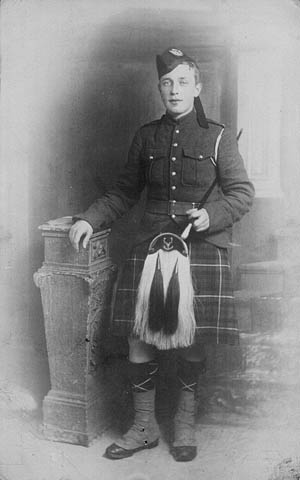
Victoria Cross recipient James Cleland Richardson in his Seaforth Highlanders of Canada uniform. [Wikimedia]
None of his tunes, however, held such stock as those that he performed on the front lines during the Battle of Ancre Heights in early October 1916. His actions not only helped inspired his company to escape the shell holes of Regina Trench and attack the Germans, but earned him the Victoria Cross as well.
“Realising the situation,” says his citation, “Piper Richardson strode up and down outside the wire, playing his pipes with the greatest coolness. The effect was instantaneous.” This Nov. 25 marks the 128th anniversary of his birth and Richardson remains beloved in his hometown of Chilliwack, B.C.
Born in 1895 in Bellshill, Scotland, Richardson grew up with seven siblings. He joined the local Boy Scouts where he developed his passion for the bagpipes.
His family eventually moved to Vancouver in August 1913, where Richardson worked at a factory. He was still an avid bagpiper, though, even winning three first-place prizes during a competition in Victoria in 1914. That same year, Richardson also proved himself a local legend when he rescued a drowning boy in a Vancouver creek.
Following the outbreak of the First World War, Richardson wanted to be more than just the stuff of local lore and he joined the Seaforth Highlanders of Canada. He went overseas with the 16th Battalion, Canadian Expeditionary Force, one of the 110 original members of the new unit.

The James Cleland Richardson statue in front of the Chilliwack Museum and Archives. [Wikimedia]
In cinematic fashion, the booming timbre of Richardson’s bagpipe inspired his company to action.
When his company was sent to aid a British advance during the battle in Ancre, France, it soon found itself pinned down by heavy German fire and uncut barbed wire in no man’s land. Sensing fading morale in the fierce conditions, Richardson volunteered to play his pipes at the top of the trench. With his commander’s approval, he rose to gracefully play.
“As bullets flew past and shells dropped on the French soil round about him,” Marc McLean wrote in a Rutherglen Reformer article, “20-year-old James marched ahead and continued playing defiantly.
“He was an easy target for the Germans.”
And in cinematic fashion, the booming timbre of Richardson’s bagpipe inspired his company to action. Wrote McLean: “James’ incredible bravery inspired his company to rush the wire and capture a stronger position.”
The lively notes of his tune roused Allied victory, and once Richardson concluded his musical march he helped his company retrieve the wounded and prisoners of war.
After advancing 200 metres, Richardson discovered he had left his instrument behind and, despite company members imploring him not to, he rushed back to retrieve it. It was the last time they would see him alive.

James Cleland Richardson’s bagpipes on permanent display at the British Columbia Legislative Building in Victoria. [Wikimedia]
“For his battalion, his intimate connection with those pipes meant the difference between victory and defeat.”
Kathleen Gibson, however, rationalized Richardson’s decision in a SaskToday.ca article. “He knew its value,” wrote Gibson, “for his battalion, his intimate connection with those pipes meant the difference between victory and defeat; lives lost and lives gained. He dare not leave them behind.”
Richardson’s body and instrument were discovered later. His Victoria Cross was presented to his father on April 3, 1919. Since then, Richardson has been celebrated by Canadians. His bagpipes are now on public display at the B.C. legislature and a bronze statue of him playing his instrument stands outside the Chilliwack Museum and Archives. He was also memorialized in his birth town of Bellshill in 2016 with a remembrance stone.
“Like the biblical story of David and Goliath,” wrote Gibson, “young James wielded an unlikely weapon against the enemy. No landmine, no machine gun, no grenade; just a few pounds of wood and cloth brought to life by his own courage and breath.”
Advertisement


















